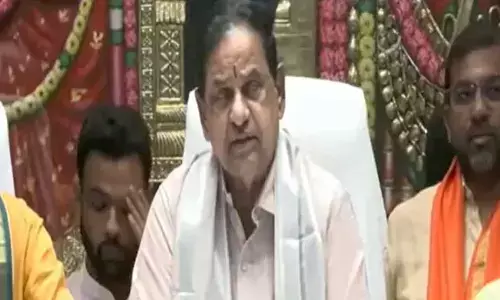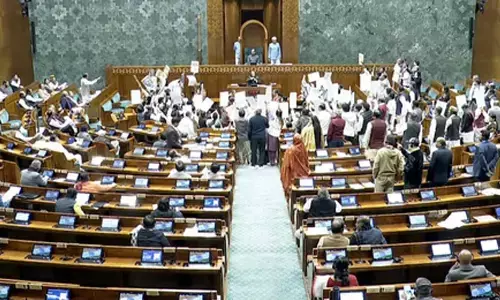One last bright spark of glorious tradition

Any literary tradition demonstrates its virtuosity and vitality in how even its last proponents keep up its standards, even as the style itself is declining due to changes in the political and social millieu and norms. The Lucknow School of Urdu Poetry was no exception. But even as we acknowledge change in times and tastes, is inevitable, it seems unfortunate for a promising poet so eclipsed.
Any literary tradition demonstrates its virtuosity and vitality in how even its last proponents keep up its standards, even as the style itself is declining due to changes in the political and social millieu and norms. The Lucknow School of Urdu Poetry was no exception. But even as we acknowledge change in times and tastes, is inevitable, it seems unfortunate for a promising poet so eclipsed.
Syed Siraj-ul-Hasan 'Siraj Lakhnavi' (1894-1968) was not the last of the Dabistan-e-Lakhnau – that dubious distinction could possibly go to his contemporary, Syed Muhammad Hasan 'Salik Lakhnavi' (1910-76) – but he was certainly among the last whose name and work struck a chord in both local connoisseurs and common men, though not much outside the region.
And that was a loss – for his métier included a penchant for a deft turn of phrase and the art of carrying one thought or meter through a ghazal; rather uncharacteristic, for it is supposed to be exempt from such unity of thought and the “nazm” is the vehicle for such a purpose. But then the Lakhnavi poets were nothing if innovative.
Take, for example, this ghazal beginning: "Samjha tha main mujhe kisi qabil bana diya/Yeh kya kiya ki dard ko phir dil bana diya" in which – save this third couplet "Itne mugaalate diye umeed-o-beem ne/Saahil ko mauj, mauj ko saahil bana diya" – he uses the radif "dil bana diya" in all.
Be it: "Itni kadi nigaah se dekha na kijiye/Har rishta-e-nazar ko rag-e-dil bana diya", "Yeh kya banaane waale tere ji mein aa gayi/Bijli bana raha tha magar dil bana diya" and finally, "Har zarrah rahguzar ka to heera nahi 'Siraj'/Jis mein salaahiyat thi use dil bana diya".
The details about Siraj's life are, despite its recentness, far from complete. Born in the Jhaulal Bazar area of Lucknow in the family of Noor-ul Hasan, he attended the city's King's College but did not complete his studies as he got a job as an excise inspector.
However, his integrity turned out to be a barrier in the post, and he eventually settled as a clerk in the department. His sole diwan "Shola-e-Aawaz" was published in 1960. However, Siraj's poetry makes up for all that. His canvas was most expansive as he sketched various facets of the human condition in his inimitable style.
Consider the unique depiction of the world in "Saans lene ki faqat tohmat hi tohmat hai 'Siraj'/Zindagi ke aaina khaane mein ek tasveer hoon", on the progress of life: "'Siraj' ab dil kashi kya zindagi mein/Yeh mushkil vaqt kaata ja raha hai", the tenuous alternative of life and dreams: "Aankhen khuli to jaag uthi hasraten tamaam/Us ko bhi kho diya jise paaya tha khvab mein" or on less than sincere people in "Kam-zarf ki niyat kya pighla huya loha hai/Bhar bhar ke chhalakte hai aksar yahi paimane".
And then if someone wants to showcase the idea of love in the setting of the famed Lakhnavi tehzeeb -- and in just around a dozen words -- then they couldn't do worse than this gem: "Aap ke paaon ke neeche dil hai/Ik zara aap ko zahmat hogi". Or its deeper considerations, "Guzarti hai jo dil par husn ke voh ishq kya jaane/Lab-e-nazuk ki har faryad be-awaaz hoti hai".
Even when he wrote on the 'staples' Urdu poetry is usually identified with, his treatment was subtly different -- be it the poet in the beloved's presence: "Is soch mein baithe hain jhukaye huye sar ham/Uthe teri mehfil se to jayenge kidhar ham", or contemplating a portrait: "Tasveer mein bhi hain vahi bigde huye tevar/Aankhon mein muravvat ka kahin naam nahin hai", or the painful memory of love: "Han tum ko bhool jaane ki koshish karenge ham/Tum se bhi ho sake to na aana khayal mein". Or even the parvana-shama motif: "Har ashk-e-surkh hai damaan-e-shab mein aag ka phool/Baghair shama ke bhi jal rahe hai parvane".
Also, the outside world with its cruel realities was never "terra incognita" for Siraj. "Lahu mein doobti hai tareekh khalqat insaan/Abhi yeh nasl hai shaista-e-hayaat kahan", or "Zahir parast zaalim yeh bhi khabar nahi hai/Kehta hain ansuon mein khoon-e-jigar nahi hai", or "Haan yehi dastoor parvana majazi hai 'Siraj'/Neend aati hai paron mein aag lag jaane ke baad" can be taken as comments on the happenings outside the poetic world in the 1940s and 1950s.
And like all great poets, he composed his own poetic farewell -- "Takraun kyun zamane se kya faeda "Siraj"/Khud apne raaste se hata jaa raha hoon main".
This could serve for the Lucknow School too.



















